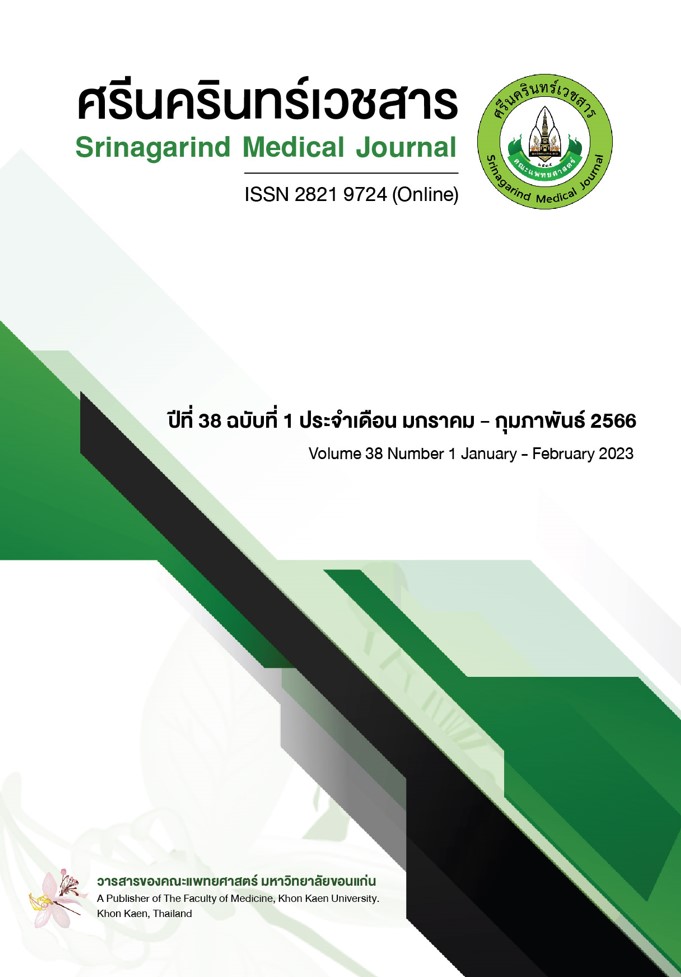ประสิทธิภาพของระบบสัญญาณเตือนก่อนเข้าสู่ภาวะวิกฤตในผู้ป่วยเด็ก (Pediatric Early Warning System-PEWS) โรงพยาบาลศีขรภูมิ
Abstract
Performance of Existing Pediatric Early Warning System (PEWS) at Sikhoraphum Hospital
Amphairat Sutthithumthaworn
Department of Paediatrics, Sikhoraphum Hospital, Surin Province
หลักการและวัตถุประสงค์: ผู้ป่วยเด็กมีโอกาสเกิดภาวะวิกฤตขึ้นแบบไม่ได้มีการวางแผนไว้ก่อน การที่สามารถระบุตัวผู้ป่วยเด็กที่มีความเสี่ยงภาวะวิกฤตได้ตั้งแต่แรกรับจะช่วยให้ผู้ป่วยได้รับการดูแลอย่างเหมาะสมและทันท่วงที การศึกษาครั้งนี้มีวัตถุประสงค์เพื่อศึกษาประสิทธิภาพของระบบสัญญาณเตือนก่อนเข้าสู่ภาวะวิกฤตในผู้ป่วยเด็ก (pediatric early warning system-PEWS) โรงพยาบาลศีขรภูมิ
วิธีการศึกษา: การศึกษาครั้งนี้เป็นการศึกษาย้อนหลัง อาสาสมัคร คือ ผู้ป่วยที่มีอายุตั้งแต่ 1 เดือนถึง อายุ 15 ปี ที่ได้รับการประเมินด้วย pediatric early warning system score (PEWS score) ระหว่างเดือนมกราคมถึงธันวาคม พ.ศ. 2564 เครื่องมือวิจัยใช้แบบบันทึกสัญญาณเตือนก่อนเข้าสู่ภาวะวิกฤตในผู้ป่วยเด็ก ซึ่งมีค่าดัชนีความตรงเชิงเนื้อหาเท่ากับ 1.00 ทดสอบความสามารถในการทำนายด้วยค่าความไว (sensitivity) ความจำเพาะ (specificity) และพื้นที่ใต้ ROC Curve
ผลการศึกษา: ผลการวิจัยพบว่ากลุ่มตัวอย่าง 123 ราย อายุเฉลี่ย 4.4 ปี (SD = 4.24) ซึ่งผู้ป่วยที่มีค่า PEWS score ตั้งแต่ 2 คะแนนขึ้นไป สามารถทำนายการนอนในโรงพยาบาลโดยมีค่าความไว ร้อยละ 73.17 ความจำเพาะ ร้อยละ 46.34 พื้นที่ใต้ ROC Curve มีค่าร้อยละ 66.11 (95%CI 0.5609-0.7611) สามารถทำนายการย้ายเข้าหอผู้ป่วยเด็กวิกฤต มีค่าความไว ร้อยละ 95.56 ความจำเพาะ ร้อยละ 50.00 พื้นที่ใต้ ROC Curve มีค่าร้อยละ 85.36 (95%CI 0.7846-0.9224) และสามารถทำนายการส่งต่อผู้ป่วยภาวะวิกฤต มีค่าความไว ร้อยละ 80.77 ความจำเพาะ ร้อยละ 37.11 พื้นที่ใต้ ROC Curve มีค่าร้อยละ 64.85 (95%CI 0.5315-0.7654)
สรุป: ระบบสัญญาณเตือนนี้สามารถทำนายการย้ายผู้ป่วยเข้าหอผู้ป่วยเด็กวิกฤตได้ดี และช่วยดักจับอาการก่อนเกิดอาการทรุดรุนแรง ทำให้ผู้ป่วยได้รับการดูแลอย่างมีประสิทธิภาพและประสิทธิผล
Background and Objective: Pediatric patients are more likely to have unplanned crises. Identifying critically at-risk pediatric patients at the time of arrival will help them receive timely and appropriate care. This study aimed to determine the effectiveness of the pediatric early warning system (PEWS) of Sikhoraphum hospital.
Method: A retrospective cohort study was conducted. The sample consisted of patients aged over 1 month to 15 years, and whose medical records were all assessed with the PEWS systems between January to December 2021. The instruments was PEWs record forms, and the content validity index was at 1.00. Data were assessed using diagnostic tests as sensitivity, specificity and discrimination areas under the ROC curve (AROC).
Result: A total of 123 children were included for analysis. The mean age was 4.4 years (standard deviation, SD = 4.24). The cut-off point for PEWS score above 2 points; to predict the need for admission with a sensitivity of 73.17 %, specificity of 46.34 % and AROC for predicting admission were 66.11 % (95%CI 0.5609-0.7611); to predict the need for PICU admission with a sensitivity of 95.56 %, specificity of 50.00 % and AROC for predicting PICU admission were 85.36 % (95%CI 0.7846-0.9224); to predict the need for refer with a sensitivity of 80.77 %, specificity of 37.11% and AROC for predicting refer were 64.85 % (95%CI 0.5315-0.7654)
Conclusion: It is recommended that PEWS is a good predictor at risk for PICU admission, which can help with diagnosis and catching symptoms prior to deterioration in order to improve the efficiency and effectiveness of patient care.
Downloads
Published
Issue
Section
License

This work is licensed under a Creative Commons Attribution-NonCommercial-NoDerivatives 4.0 International License.


